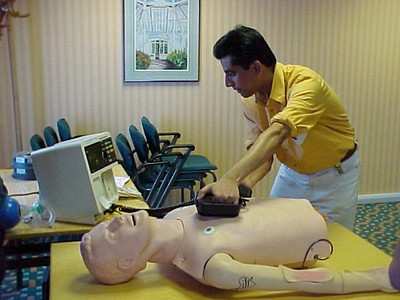Sat, Sep 27, 2008
Mirrors Implementation In Airliner Cabins
 Following in the steps of the
successful deployment of automated external defibrillators (AEDs)
in airliner cabins, the Federal Aviation Administration (FAA)
announced Friday it will install the lifesaving devices in all
agency facilities with 50 or more employees during the next
year.
Following in the steps of the
successful deployment of automated external defibrillators (AEDs)
in airliner cabins, the Federal Aviation Administration (FAA)
announced Friday it will install the lifesaving devices in all
agency facilities with 50 or more employees during the next
year.
"Our focus on aviation safety includes the safety and well-being
of our own employees. The unexpected and sudden moments in which
defibrillation can be effective require quick thought and decisive
action — traits the FAA workforce is famous for," said FAA
Acting Administrator Robert A. Sturgell. "Together our labor groups
and FAA management have made a very positive step to ensure our
employees have enhanced safety in the workplace, and I applaud all
parties for bringing this about."”
Sturgell also singled out Rep. John Kline of Minnesota for his
continuing interest in bringing AEDs to FAA facilities.
The deployment of AEDs is planned for a three-year period. In
the first year, the FAA will put AEDs in facilities with 50 or more
employees — about 68 percent of the workforce. The agency
will then evaluate implementation costs and whether a sufficient
number of employees are volunteering to be responders.
Pending positive results of the evaluation, the FAA intends to
deploy AEDs to the remaining FAA facilities with 10 or more
employees during the following two years, which cover 97 percent of
agency personnel. FAA facilities experience an average of one
sudden cardiac arrest per year among more than 46,000
employees.
The number of AEDs installed will depend on the geographic
layout of a particular facility and the number of employees working
there. The goal is to be able to retrieve the AED and have a
trained volunteer apply the device (if appropriate), all within
three to five minutes of finding a sudden cardiac arrest victim.
While the FAA hopes enough employees will volunteer as lay
responders to have good facility and shift coverage, the agency
cannot guarantee a trained responder will be on site at all times
at all facilities with AEDs.

One or more vendors will provide the AEDs, cabinets, training,
tracking, medical oversight, and replacement parts. Estimated cost
of the contracts is $15 million over a 10-year period.
More News
Also: B-29 Superfortress Reunion, FAA Wants Controllers, Spirit Airlines Pulls Back, Gogo Galileo Van's Aircraft posted a short video recapping the goings-on around their reorganiz>[...]
Light Gun A handheld directional light signaling device which emits a brilliant narrow beam of white, green, or red light as selected by the tower controller. The color and type of>[...]
"The journey to this achievement started nearly a decade ago when a freshly commissioned Gentry, driven by a fascination with new technologies and a desire to contribute significan>[...]
"Our driven and innovative team of military and civilian Airmen delivers combat power daily, ensuring our nation is ready today and tomorrow." Source: General Duke Richardson, AFMC>[...]
Aircraft Conflict Predicted conflict, within EDST of two aircraft, or between aircraft and airspace. A Red alert is used for conflicts when the predicted minimum separation is 5 na>[...]
 Airborne 04.16.24: RV Update, Affordable Flying Expo, Diamond Lil
Airborne 04.16.24: RV Update, Affordable Flying Expo, Diamond Lil ANN's Daily Aero-Term (04.20.24): Light Gun
ANN's Daily Aero-Term (04.20.24): Light Gun Aero-News: Quote of the Day (04.20.24)
Aero-News: Quote of the Day (04.20.24) Aero-News: Quote of the Day (04.21.24)
Aero-News: Quote of the Day (04.21.24) ANN's Daily Aero-Term (04.21.24): Aircraft Conflict
ANN's Daily Aero-Term (04.21.24): Aircraft Conflict




